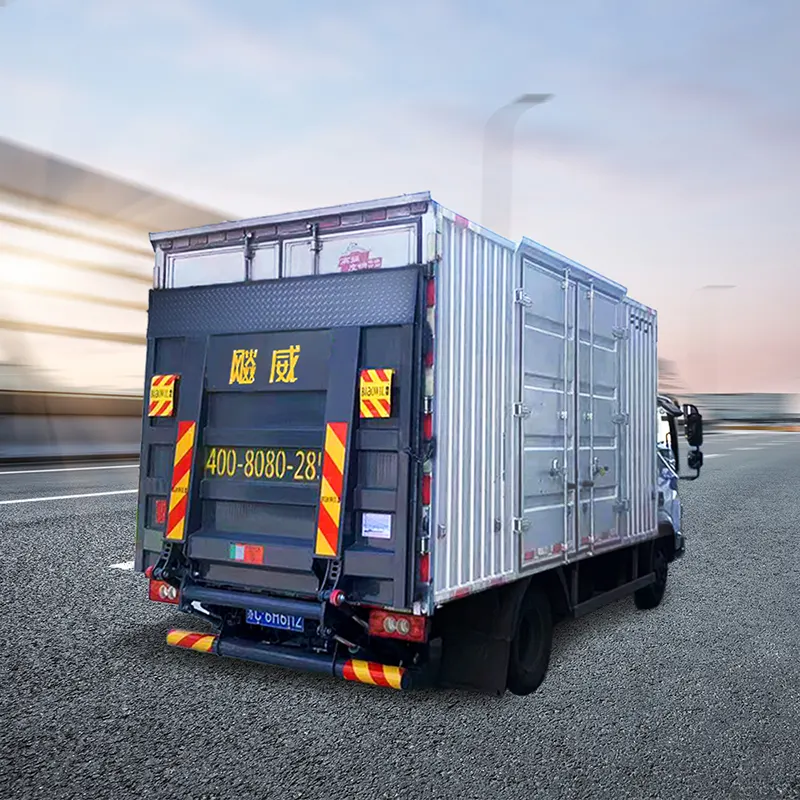テールリフトはどれくらいの重量を持ち上げることができますか?
テールリフトに関しては, 体重は考慮する必要がある重要な要因です. テールリフトは、トラックやトレーラーの背面に重いアイテムや機器を持ち上げるために使用されます, そして、彼らは彼らが運んでいる体重を処理するのに十分な強さである必要があります. この記事では, テールリフトが持ち上げることができる重量を決定する要因を探ります, そして、あなたがあなたのニーズに合わせて右のテールリフトを選択するためにあなたが知っておくべきこと.
テールリフトとは何ですか?
テールリフトは、トラックまたはトレーラーの後端に取り付けられた油圧または機械装置です. アクティブ化されたとき, 重いアイテムや機器を車両の背面に持ち上げるために使用できるプラットフォームを拡張します. テールリフトにはさまざまなサイズと能力があります, そして、それらは永久に取り付けたり、取り外したりすることができます.
テールリフト容量を決定する要因
テールリフトの容量はいくつかの要因によって決定されます, 負荷の重量を含む, リフトプラットフォームの長さ, 油圧シリンダーのサイズ, 取り付けブラケットの強さ. テールリフト容量を決定する重要な要素のいくつかは次のとおりです:
1. 重量を積みます
負荷の重量は、テールリフトの容量を決定する最も重要な要素です. 各テールリフトは、特定の重量範囲を処理するように設計されています, そして、この制限を超えると、リフトが故障したり誤動作したりする可能性があります. テールリフトを選択する前に輸送する負荷の重量を知ることが不可欠です.
2. プラットフォームの長さ
リフトプラットフォームの長さは、テールリフトの容量にも影響します. より長いプラットフォームは、より多くの重量をサポートできます, しかし、彼らはまた、曲げや破壊を防ぐために、より大きな油圧シリンダーと強い取り付けブラケットを必要とします. 大きなアイテムや重いアイテムを輸送する必要がある場合, より長いプラットフォームでテールリフトを選択してください.
3. 油圧シリンダーサイズ
油圧シリンダーのサイズは、テールリフトがリフトできる重量の量を決定します. 大きなシリンダーは、より多くの力を生成できます, リフトが重い荷物を処理できるようにします. しかし, 大規模なシリンダーは、より多くの液体を動作させる必要があります, これは、リフティングが遅くなったり、効率が低いかにつながる可能性があります.
4. 取り付けブラケット
トラックまたはトレーラーにテールリフトを取り付ける取り付けブラケットも、容量を決定する上で重要な役割を果たします. ブラケットは、リフトの重量と力に耐えるのに十分な強さでなければなりません, または、彼らは車両を壊したり離したりすることがあります. 高品質のテールリフトを選択することが重要です, 安全で信頼できるパフォーマンスを確保するための耐久性のある取り付けブラケット.
テールリフトカテゴリ
テールリフトは、容量と設計に基づいていくつかのカテゴリに分類されます. これは、最も一般的なテールリフトカテゴリの簡単な概要です:
1. 列リフト
柱のリフトは、テールリフトの最も一般的なタイプです, そして、それらは範囲の負荷を処理するように設計されています 500 kg to 3000 kg. それらは、垂直列のセットに沿って上下に移動する2つまたは3つの油圧シリンダーを備えています, プロセスでプラットフォームを持ち上げる. 列リフトは、幅広いアプリケーションに適しています, 配達を含む, 分布, 一般貨物.
2. カンチレバーリフト
カンチレバーリフトは、列リフトに似ています, しかし、それらはマウントから伸びる単一の油圧シリンダーを備えています, プロセスでプラットフォームを持ち上げる. それらは、範囲の負荷を処理するように設計されています 500 kg to 1500 kg, そして、それらはしばしばより小さな配送車両に使用されます, バン, ピックアップトラック.
3. タッカウェイリフト
タッカウェイリフトは、使用していないときに車両の後部の下にきちんと挟まれる折りたたみ式のテールリフトの一種です. それらは、範囲の負荷を処理するように設計されています 500 kg to 1500 kg, そして、それらはしばしばより小さな配送車両に使用されます, バン, ピックアップトラック.
4. スライダーリフト
スライダーリフトは、タッカウェイリフトに似ています, しかし、それらはプラットフォームが水平に拡張および撤回できるようにするスライドメカニズムを備えています. それらは、範囲の負荷を処理するように設計されています 500 kg to 1500 kg, そして、それらはしばしばより小さな配送車両に使用されます, バン, ピックアップトラック.
右側のテールリフトを選択します
右のテールリフトを選択することは難しい作業になる可能性があります, 考慮すべきいくつかの要因があります. 留意すべき重要な考慮事項は次のとおりです:
1. 重量を積みます
負荷の重量は、テールリフトを選択する際に考慮すべき最も重要な要素です. あなたが輸送する最も重いアイテムまたは機器の重量を知っていることを確認してください, そして、この体重を安全かつ確実に処理できるテールリフトを選択してください.
2. プラットフォームの長さ
リフトプラットフォームの長さも重要な考慮事項です. より長いプラットフォームは、より多くの重量をサポートできます, しかし、彼らはまた、より大きな油圧シリンダーとより強い取り付けブラケットを必要とします. 大きなアイテムや重いアイテムを輸送する必要がある場合, より長いプラットフォームでテールリフトを選択してください.
3. 取り付け方法
テールリフトがトラックまたはトレーラーにどのように取り付けられるかを考えてください. 永久マウントはより安全ですが、柔軟性が低くなります, 取り外し可能なマウントはより多くの汎用性を提供しますが、そうではないかもしれません
